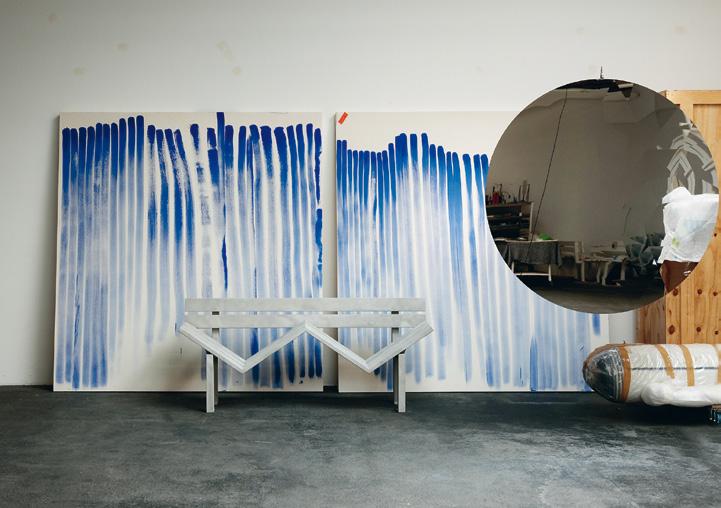
4 minute read
Jeppe Hein
Jeppe Hein is considered one of the most important Scandinavian contemporary artists. His works combine elements of minimalist and conceptual art, and focuses on human interaction particularly in terms of social relationships.
Jeppe, you completed an apprenticeship as a furniture maker. To what extent did it influence your understanding of art and craftsmanship?
Advertisement
It influenced me a lot, I’m aware of its influence every day. When you have learned a craft, you have to practice it intensively. It has a great influence on how you think in everyday life and how you proceed with new projects. You develop a practice-oriented, structural knowledge that is very important for many processes. This has helped me not only at home, but particularly in the studio. Every colleague here is an expert in his or her field, but with that knowledge you can challenge them a bit.

You used to worked as an assistant for Ólafur Elíasson. Did he influence you?
Yes of course. I was one of his first assistants and I was also the first to cook in his studio. He had a small studio, only two or three employees. I was allowed to travel around a lot, help build up his studio and learned a lot in the process. I was fortunate to meet many people. That also helped my career, because I always made a little bit of art on the side. So I was able to make contacts and organize my first exhibition. Ólafur was a great inspiration. At the time, he was making “natural wonder” art, very intense works that you can feel on your skin and in your heart. And I was directly involved, it was a wonderful feeling. Art has to come from the heart – I try to do that with all my work. He also always brought in playfulness. I try to do that as well. First I sit down and meditate. I used to get inspiration while traveling, simply keeping my eyes and ears open, activating my senses, feeling what’s happening. How do I interact with people? How can I inspire an angry or tired person? I watch people, how they interact, what they might feel, how their movement pattern and social interaction is in everyday life. And I experiment. I develop ideas for art actions that take these people out of their personal comfort zone. Watching people play is great because people come out of themselves and let go of their stiffness and control. I like doing that. And, like playing, I want to open people’s hearts. I think my work does that quite well because it is playful both with the tools and with the art itself. I always use the term “tool” with regard to my artwork.
Community and interaction play an important role in your art. Why did you put this at the center of your work?
Growing up in Denmark, you experience social relationships very differently than in Germany. Society, the school system, and friendships all function differently. It is a small country. Education and art studies are free. You even get money for studying. This gives you different motives to make art. In the UK, for example, you have to earn money to pay off student loans. The more positive interaction in society and with my parents, who are old hippies, have had a great influence on my life and my art, particularly the interaction with people and the exchange with one another.
You dealt with your burnout experience quite openly. To what extent has it changed your art?
It was a big break for my entire life. I asked myself: What do I want? I used to want a Porsche. Now I am the Porsche. That was a quote from an exhibition at Kunstmuseum Wolfsburg. The form of my art is still the same, but the content has expanded. I have gained a spiritual view. A collector I met recently bought a very early work of mine. Enlightenment – at that time I didn’t even know what the term actually meant, I found it superficially simply beautiful. Now I question my work more strongly. I think there is a consciousness. It’s up there and we have to bring it down. I’m trying to do that: to give everything from my heart for my art, even when I’m angry, to articulate my feelings. I have observed myself, meditated, participated in yoga. New feelings come up and I try to implement them.
Some say you are a conceptual artist, others think you do minimal or kinetic art. How would you classify your work?
Ten years ago, when my second life began after my severe burnout, I started to look at my work in a completely different way. Not that I gave up things. I still make mirrors. But before that I mainly brought minimalist sculptures to life. One had a cube or a white cube, one had movements in art. The artwork began to tremble when one came close to it. Art was afraid of the viewer. Minimal sculpture. It was about surface, form, lines! My sculptures have always been social. “Trust the artwork.” Sit on it. If you ask me, I am now working even more with social issues and yet I have kept my radical minimalism, as minimal as possible. Even my email is very minimal. With it I try to uncover the social aspects of our society. This has been the focus of my work for fifteen years: How do you deal with yourself, how do you deal with people?
read the full story on bit.ly/_JeppeHein
Interview: Kevin Hanschke
Jeppe Hein is represented by KÖNIG Galerie, Berlin/London/Tokyo 303 Gallery, New York City Galleri Nicolai Wallner, Copenhagen SCAI The Bathhouse, Yanaka






